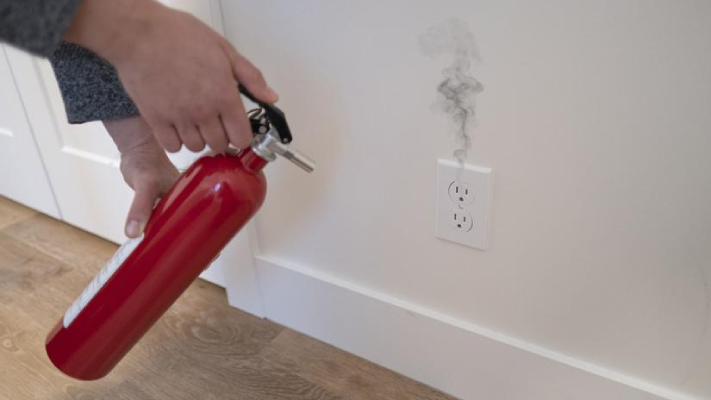
Mr. Electric explains how to safely address a smoking electrical outlet.
|
If you notice an electrical outlet smoking, it’s a serious issue that requires immediate action. Knowing how to fix a smoking outlet, or at least what to do if it happens, can keep your home and your family safe. A first step – beyond ensuring that your family is ready to evacuate – is figuring out why the electrical outlet is smoking and whether there is already a fire within the wall. If you’ve just plugged something in and suddenly notice a burning smell and/or see small wisps of smoke, you may be able to avert a full-blown fire by following these steps:
- Quickly turn off the circuit and unplug the device.
- Carefully feel the wall near the outlet. If it feels hot, or if smoke is increasingly pouring out of the outlet, evacuate the house and call 911 immediately. (Be sure that your smoke alarms are ready to go before an emergency occurs!)
- Although waiting for help is always the safest option, if you’re determined to stop a small fire from spreading, use an appropriate fire extinguisher – only powder-based or CO2 extinguishers should be used on electrical fires. Never try to put out an electrical fire with water! Doing so could result in electrocution.
- If the wall isn’t hot and the smoke stops once the device has been unplugged, investigate to determine what caused the issue.
- Do not turn the power to the circuit back on until you’ve figured out what caused the problem. For your safety, it’s best to have a licensed electrician assess the situation before proceeding.
Causes of Smoking Electrical Outlets
What’s more important than knowing how to fix a smoking electrical outlet? Knowing how to prevent the problem in the first place! In addition to smoke, other things that indicate a possible problem include a faint burning odor, outlets that are warm to the touch, or ones that have blackened or charred marks on them. Common causes of an electrical outlet smoking include:
- Wiring Issues
Loose wires, damaged connections, or faulty grounds anywhere within your household’s electrical system can cause arcing, leading to smoke and fire. Smoke from fires within the wall may escape through outlets. If you see smoke coming out of an outlet that is not in use, it’s a sign that the problem may be deeper than the wall outlet. If this is the case, turn off the circuit at the breaker box immediately. Check the wall for heat. Evacuate and call 911, if necessary. Do not restore power to the circuit until a licensed electrician has inspected the circuit.
- Debris Inside the Outlet
Dust or dirt inside an electrical outlet can cause a short circuit. A build-up of debris can transfer electricity, causing arcing between negative and positive wirings. This creates heat and is a potential fire hazard. To clean electrical outlets, turn off the outlet’s circuit in the electrical breaker box. Once you’re sure that the power supply to the outlet is off, use a screwdriver to remove the outlet cover. Use a vacuum attachment to remove debris from inside the outlet box and plugs. Wipe the cover with a damp rag. Wipe plug outlets while the power is still off. Do not spray anything near the plugs or get water or cleaning solutions inside the prong holes. Allow everything to dry thoroughly before replacing the outlet covers and restoring power to the circuit.
- Overloaded Outlets
With such an abundance of electrical devices and appliances in today’s homes, it’s no surprise that overloaded outlets are a common cause of smoking electrical outlets. Many household circuits are only designed to handle a load of 15 or 20 amps. If you have several items plugged into the same circuit, the power demand from the combination of devices may exceed the load capacity of the circuit. Usually, this activates the circuit breaker, which shuts down power to the circuit. If the circuit breaker doesn’t trip, or if you persist in trying to run too many devices on the circuit, the overload will generate excess heat, leading to smoldering wires, smoke, and possibly fire. Don’t ignore tripped circuits. If a circuit routinely trips, disconnect a few items and operate them on another circuit or consult with a licensed electrician to upgrade electrical circuits.
- Loose Connections/Corrosion
For electricity to flow properly, connections between a device’s plug and the receptacle must be secure. Sometimes heavy use can cause outlets to become worn, cracked, or corroded, affecting the way in which the prongs connect to the receptacle. Devices should plug in snugly. Loose connections cause sparks or arcing as the current jumps the gap. The arcing produces heat, which may cause smoke. If you notice a wiggly plug, the outlet may be damaged and should be replaced.
Electrical Issues are Not for Novices – Hire a Professional!
There’s no doubt that electricity has transformed our lives over the past century, but sometimes we forget its fearsome power. When contained within a functioning, up-to-date electrical system, it provides us with endless modern conveniences and pleasures. But, if given the opportunity to escape its pathways and run amok, it can be devastating, putting our homes and our lives at risk.
That’s why instead of asking how to fix a smoking outlet, maybe you should ask “Who should fix a smoking outlet?” With so much at stake, don’t trust just anyone to fix damaged wiring or upgrade electrical components. If you have a smoking outlet, contact your local Mr. Electric® to fix the problem. Or, better yet, call to schedule an appointment for immediate assistance, before something goes awry!

